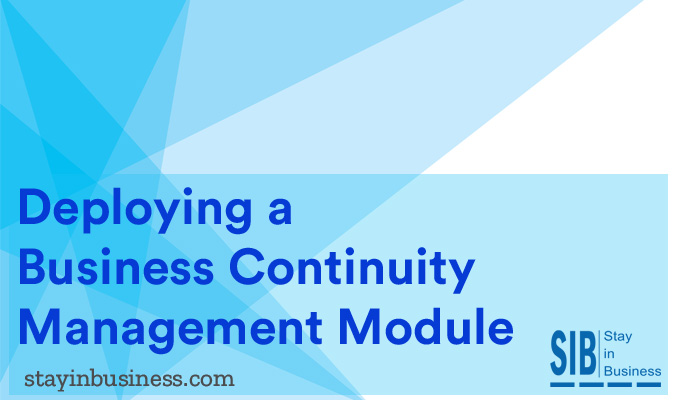
Business Continuity Management
The SIB platform lets you deploy business continuity management modules as a portfolio of multiple interconnected projects that collectively achieve a common goal. You can use the Stay in Business application to leverage collaborative efforts across a number of tasks and activities such as:
- Educatingemployees on the benefits and significance of introducing a business continuity policy
- Collatingdata to make an informed decision on the most feasible business continuity options that match the organization’s resiliency targets
- Preparinga blueprint for action in response to the different types of incidents that can occur and disrupt business
- Preventingimpact on business by fortifying systems and processes against threats
- Testingthe business continuity management module’s capabilities through drills, simulations and exercises
You can use the platform to manage the staffing requirements of your business continuity plans by transferring skills and expertise through training programs. Maintenance is a key aspect of deploying a business continuity management module and your employees can keep the business continuity management module up to date through frequent changes and improvements.
You can also plan the introduction of new features and functionalities into the systems based on forecasted needs and requirements. Stay in Business lets you immediately trigger BCDR plans in the event of a crisis situation through a process driven framework for operations.
Deployment Approach
The existing organizational culture plays a huge role when business continuity executives gauge the feasibility of different business continuity management strategies. Stay in Business lets you design business continuity plans of varying levels of detail depending on the skills, expertise and capabilities of your staff and personnel.
Our panel of experts and specialists can assist you in creating a business continuity module. This way, you can take advantage of our expertise in the field as we can help you create BCDR plans that are highly effective and cost efficient. What’s more, we can also bridge any gaps in the skills and expertise of your staff through periodic training modules.
Procedural Framework
You can use Stay in business to broadly categorize your business continuity management module into the following stages:
- Project Initiation
- BCM lifecycle preparation, coordination and execution
- Getting acquainted with the company’s organizational structure
- Identifying the most appropriate BCM strategy
- Engineering a framework for response
- Managing the plan through regular maintenance
- Developing communication strategies for keeping employees and staff up to date on the latest trends and developments in business continuity
- Fostering a culture of continuous improvement
- Project initiation can include numerous activities, such as:
- Will it address the needs of only standalone entities
- Cater to specific segments of operations or
- Provide an enterprise wide solution
- Organizing forums of discussion amongst upper management and leadership teams to evaluate the consequences of not developing a framework for incidence response
- Evaluating the statistics on recent business disruptions that impacted other companies in the organization’s immediate environment
- Investigating the present capabilities of the organization to respond to a crisis
- Establishing the extent of resiliency of the proposed business continuity program. Will it:
- Address the needs of only standalone entities
- Cater to specific segments of operations or
- Provide an enterprise wide solution
- Outlining a preliminary draft on BCM policy
- Gathering data and evaluating the practicalities of various business continuity options
- Initiating mitigation measures to curb the impact of identified threats
- Developing operational protocols for incident management
- Identifying cost effective approaches to execute the plan
Project management methodologies are ideally suited for executing tasks and activities while preparing, coordinating and executing BCM life cycle. Detailed monitoring during this stage is essential to avoid repercussions during later stages.
Takeaways and Evaluation
SIB lets you gauge the successful deployment of a Business Continuity Management module by the following factors:
A readily available response framework that can be triggered the moment an incident occurs. During the time leading to this moment when the response is deployed, emergency teams have been notified through alert warnings and are on standby
A fully functional mechanism that has been put in place to upgrade the BCM module’s capabilities through updates, enhancements and training programs. The plan is regularly updated and stays in sync with the resiliency objectives that evolve over a period of time as the organization expands business operations.
See for yourself how the application works
Witness our cloud based platform’s security capabilities in action
Play around with the software and explore its features
Compare and choose a solution that’s relevant to your organization
Consult our experts and decide on a pricing mechanism
Disasters
[carousel id=’1780′ items=’4′ items_desktop=’3′ margin_right=’5′ navigation=’false’] [item img_link=”https://www.stayinbusiness.com/wp-content/uploads/2016/02/Chemical-Spills-Discharges.jpg” href=”https://www.stayinbusiness.com/resource/disaster-recovery/chemical-spills-and-discharges/”][item img_link=”https://www.stayinbusiness.com/wp-content/uploads/2016/02/Riots-Public-Disturbances.jpg” href=”https://www.stayinbusiness.com/resource/disaster-recovery/riots-and-public-disturbances/”][item img_link=”https://www.stayinbusiness.com/wp-content/uploads/2016/02/Terrorism.jpg” href=”https://www.stayinbusiness.com/resource/disaster-recovery/terrorism/”] [item img_link=”https://www.stayinbusiness.com/wp-content/uploads/2016/02/worst-product-recall.jpg” href=”https://www.stayinbusiness.com/resource/disaster-recovery/product-recall/”] [/carousel]
